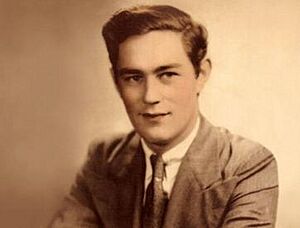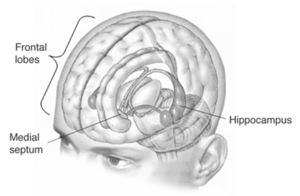Henry Molaison facts for kids
Quick facts for kids
Henry Molaison
|
|
|---|---|

Molaison in 1953 before his surgery
|
|
| Born |
Henry Gustav Molaison
February 26, 1926 Manchester, Connecticut, U.S.
|
| Died | December 2, 2008 (aged 82) |
Henry Gustav Molaison (born February 26, 1926 – died December 2, 2008) was an American man. He was widely known as H.M. He had a special brain surgery to try and stop his epilepsy. This surgery removed parts of his brain, including most of his hippocampi.
Even though the surgery helped control his seizures, it had a big side effect. Henry could no longer form new memories. His unique case became very important for science. It helped doctors understand how the brain creates memories. It also showed how important it is to get a patient's permission for medical procedures.
Henry's life after surgery showed the challenges of living with severe memory loss. His story helped many healthcare workers and families dealing with similar conditions.
A bicycle accident when Henry was a child might have caused his epilepsy. He started having small seizures at age 10. By age 16, his seizures became very severe. Even with strong medicine, Henry's seizures made it hard for him to live a normal life.
When he was 27, a brain surgeon named W. B. Scoville offered Henry an experimental surgery. The surgery happened in 1953. Scientists studied Henry from 1957 until he died in 2008. He lived in a care home in Windsor Locks, Connecticut. His case was key to understanding how the brain and memory work together. It also helped create cognitive neuropsychology. This is a field that studies how brain parts affect thinking.
After Henry Molaison died, his brain was kept at the University of California, San Diego. It was carefully sliced into tiny pieces for study. Later, it moved to the MIND Institute at UC Davis. A detailed map of his brain was made public in 2014.
Contents
Henry Molaison's Life Story

Henry Molaison was born on February 26, 1926, in Manchester, Connecticut. He suffered from severe epilepsy. Some people think a bicycle accident when he was seven caused it. He had small seizures for many years. Then, after his 16th birthday, he started having major seizures. He worked on an assembly line for a while. But by age 27, his seizures were so bad that he could not work or live a normal life. This was true even with a lot of medicine.
In 1953, Henry was sent to William Beecher Scoville. He was a brain surgeon at Hartford Hospital. Dr. Scoville believed Henry's seizures came from a part of his brain called the medial temporal lobes (MTLs). He suggested removing these parts. On September 1, 1953, Dr. Scoville removed parts of Henry's brain from both sides. This included his hippocampi and most of his amygdalae.
After the surgery, Henry's seizures were partly controlled. But he developed a severe problem called anterograde amnesia. This meant he could not form new memories about events. He could still remember things for a short time, like a phone number. He could also learn new skills, like riding a bike. But he could not remember new facts or events that happened after his surgery.
He also had some retrograde amnesia. This meant he could not remember most events from one to two years before his surgery. He even forgot some things up to 11 years before. This showed that his memory loss was worse for events closer to the surgery.
Dr. Scoville and a scientist named Brenda Milner first wrote about Henry in 1957. They called him "H.M." His full name was not shared with the public until after he died. Scientists told him how important his condition was. They told him he was famous in brain research. But he could not remember these facts as new memories.
Near the end of his life, Henry often did crossword puzzles. He could fill in answers that he learned before 1953. For information after 1953, he sometimes changed old memories with new facts. For example, he could add a memory about Jonas Salk by changing his memory of polio.
How H.M. Changed Our Understanding of Memory
Henry Molaison's case was very important. It taught us a lot about memory loss and amnesia. His exact brain surgery helped scientists understand how specific brain areas are linked to memory. His case helped create new ideas about how normal memory works.
For example, Henry could remember things for a short time. He could also learn new skills. But he could not remember new long-term events. This showed that different parts of the brain handle different types of memory. Also, he could remember old long-term memories from before his surgery. But he could not make new ones. This suggested that making and recalling long-term memories use different brain systems.
However, brain scans of Henry in the late 1990s showed that the damage was larger than first thought. This made it harder to point to just one brain area for his memory problems.
Henry Molaison's Scientific Contributions
Studying Henry Molaison changed how we understand human memory. His case helped disprove old ideas and create new ones. These new ideas explained how memory works and which brain parts are involved.
Henry's brain was studied in great detail. Scientists wanted to see the exact brain changes that caused his memory problems. In 2009, scientists made 2401 thin slices of his brain. In 2014, they finished a 3D digital model of his brain. This model was made public for free on the Internet.
The study found something surprising. About half of Henry's hippocampal tissue had survived the 1953 surgery. This changed how scientists understood his case. It meant he was not a "pure" hippocampus patient as once thought. They also found a new, unexpected injury in his prefrontal cortex. These findings mean scientists might need to look again at old test results. The 3D model showed how the surgery might have caused the brain damage.
The study also looked at the overall health of Henry's brain. He was 82 when he died, so his brain had aged a lot. Scientists found several problems that had added to his thinking decline.
Amnesia and the Brain
Henry Molaison had severe anterograde amnesia. This means he could not form new long-term memories. He also had retrograde amnesia that was worse for recent memories. Since he had no memory problems before surgery, removing his medial temporal lobes caused his memory disorder. This showed that these brain parts are key for forming long-term memories. Other patients with similar brain injuries have also shown this.
Even with his amnesia, Henry did well on intelligence tests. This showed that some memory functions were not harmed by the surgery. For example, his short-term memory was fine. He could remember numbers for a short time, just like people without memory problems. This proved that short-term memory does not rely on the medial temporal lobes.
Learning New Skills
Henry Molaison could also learn new motor skills. This was true even though he could not remember learning them. In the 1960s, a scientist named Brenda Milner did a study. Henry learned to draw a figure by looking at its reflection in a mirror. He had to trace a star between two other stars. He could only look at his paper and pencil in a mirror.
Like most people, he made many mistakes at first. But he got better with each try. He made fewer errors each day. He improved even though he had no memory of doing the task before. Milner concluded that parts of the brain for unconscious motor skills can remember things the conscious mind forgets. These parts were not damaged in Henry's brain.
Other studies also showed Henry could learn new motor skills. He could also learn through something called "repetition priming." This is when you get faster or better at a task because you've done it before, even if you don't remember doing it. These findings showed that memory for skills and habits uses different brain parts than memory for facts and events. This was a big step in understanding human memory. It showed that long-term memories are not all the same.
Spatial Memory
Studies of Henry's memory also taught us about spatial memory. This is the ability to remember places and layouts. Even with his severe memory loss, Henry could draw a very detailed map of his home. This was surprising because he had moved into the house five years after his surgery. Scientists thought he would not be able to learn the layout of a new place.
Scientists think Henry could draw the map because he walked around his house every day. This daily movement helped him build a "cognitive map" of the space. This showed that some parts of his brain for spatial processing were still working.
Henry also showed some ability to recognize pictures and famous faces. This was especially true if he was given a hint. These findings showed that other parts of his brain, not just the hippocampus, were important for memory. They also confirmed that the hippocampi are strongly linked to spatial memory.
Memory Consolidation
Henry Molaison's case also helped us understand memory consolidation. This is the process where short-term memories become stable long-term memories. Henry had retrograde amnesia that was "temporally graded." This means he could remember childhood memories. But he had trouble remembering events that happened just before his surgery.
His very old memories were fine. But memories from closer to the surgery were not. This showed that very old childhood memories do not rely on the medial temporal lobe. But more recent long-term memories seem to need them. Scientists believe the medial temporal lobes help store memories in other parts of the brain over time.
See also
- Cognitive neuropsychology
- Kent Cochrane, a similar patient who lost episodic memory after a motorcycle crash
- Clive Wearing, whose amnesia appeared after an infection
- Phineas Gage, a 19th-century railroad worker who survived an accident where a metal rod went through his brain
- Cenn Fáelad mac Ailella, a 7th-century Irish scholar who developed an extremely strong memory after a head injury
- Dark Matters: Twisted But True, an episode featured Henry Molaison's case.
- S.M., a patient who lost her ability to fear due to bilateral amygdala destruction

